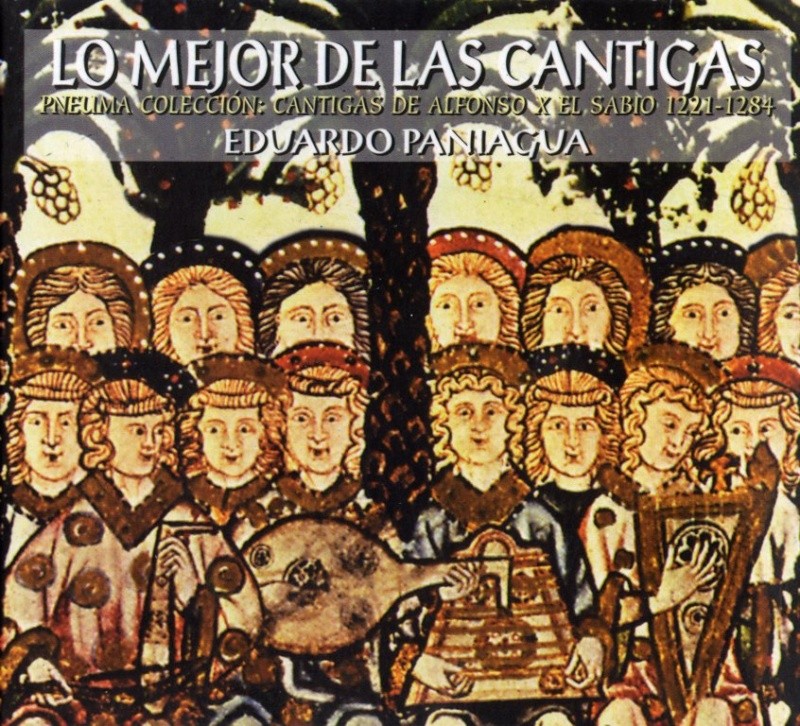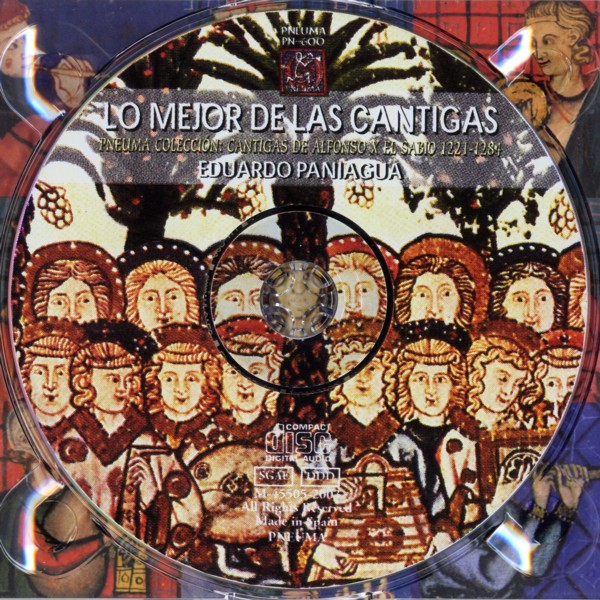Lo mejor de las Cantigas / Eduardo Paniagua
PNEUMA: COLECCIÓN CANTIGAS DE ALFONSO X EL SABIO 1221-1284

medieval.org
Pneuma PN-600
2003
1. ELTORO DE PLASENCIA. Con razon é d'averen gran pavor [3:42]
CSM 144
canto, corneta, órgano portátil, salterio, cítola,
fídula, flauta, tombak y atabal
Cantigas de Extremadura, #1 (abreviada, 8:11)
2. LAS RELIQUIAS. Ben guarda Santa Maria [3:53]
CSM 257
contratenor, soprano, tenor y bajo, cítara, chorus, viola y
cántara
Cantigas de Sevilla, CD2 #2 (abreviada, 7:30)
3. ALEXANDRIA [O que pola Virgen de grado seus dões] [2:55]
CSM 145
vihuela, salterio, cítola, viola, corneta, flauta, sonajas y 2 darbugas
Virgen de Atocha. Cantigas de Madrid, #1
4. MONJA Y CABALLERO. Do dem' a perfia [5:06]
CSM 285
canto soprano y contratenor, coro, cálamo, viola, salterio,
vihuela, cítara, corneta, flauta, campanil, cántara y dumbek
Virgen de Atocha. Cantigas de Madrid, #5 (abreviada, 14:50)
5. Cantand' e en muitas guisas [4:44]
CSM 291
voces, laúd, zanfona, flauta, kaval, pandero y castañuelas
Cantigas de Castilla y León, 6 (abreviada, 8:21) | SALAMANCA-ZAMORA
6. Milagros muitos pelos reis faz Santa María [3:20]
CSM 122
canto, viola, laúd, flauta, fhal y tambor charro
Cantigas de Toledo, 7 (abreviada, 7:25)
7. LA MUJER DE ALCÁZAR DE SAN JUAN. A que as
portas do ceu abriu [3:42]
CSM 246
soprano y coro, cálamo, flauta, dulcimer, tromba marina y nacarés
Cantigas de Castilla-La Mancha, 2 (abreviada, 8:16)
8. EL NIÑO DE SAN MARCOS. Como a voz de Jesu-Cristo [3:14]
CSM 381
contratenor, soprano y coro - silbote, chicotén, ocarina,
psalterio, cítola, tar, cántara de Villa Real y palmeado sobre agua
Cantigas de Jerez, 3 (abreviada, 5:43)
9. LA PEDRADA. De toda enfermidade [3:17]
CSM 385
soprano y coro, kaval, laúd, viola, chorus, nacares, panderete y salterio
Santa María del Puerto I, 9 (abreviada, 5:14)
10. EL JUGLAR DE LOMBARDÍA. Par Deus, muit' é gran dereito [2:19]
CSM 293
sopranos 1 y 2 y coro - vihuela, bandurria, kaval, bendir, espadilla y dos carracas
Cantigas de Italia, 2 (abreviada, 4:46)
11. LA PEDRADA DEL TAHÚR DE CHATEAUROUX. Pois que
Deus que sa Virgen [3:54]
CSM 38
sopranos, contratenor, tenor y coro - vihuela, fídula,
flauta tenor, canno y campanil
Cantigas de Francia, 4 (abreviada, 8:32)
12. LOS HALCONEROS. Carreiras e semedeiros [3:49]
CSM 243
canto, coro, salterio, dulcimer, darbuga, atabal y cascabeles
Bestiario. Cantigas de animales, 2 (abreviada, 5:56)
13. En todo nos faz merçee [2:09]
CSM 375
canto, santur, psalterio, flauta, tromba marina, darbuga, castañuelas
Remedios curativos, 7 (abreviada, 3:57)
14. HUMANIDAD DE SANTA MARÍA. Quantos me creveren
loaran [2:27]
CSM 120
contratenor, tenor y coro, chalumeau, gaita en sol, pandera, darbuga y tambor
La Vida de Maria, CD1 #10
15. VIEJA Y NIÑA. Vella e Ninya [7:30]
CSM 180
sopranos, coro de niños, santur, viola, laúd
árabe, salterio, axabeba, flauta tenor, cantara,campanilla y címbalos
La Vida de Maria, CD1 #9 (abreviada, 14:20)
16. CABALLERO CELOSO. Com'á gran pesar a Virgen [4:07]
CSM 341
bajo, tenor, soprano y coro, cítola, bandurria, laúd,
fhal, kaval, sacabuche, pandero, sistro de cuerno y sistro de aros de madera
Caballeros, #5 (abreviada, 7:27)
17. Sobelos fondos do mar [3:53]
CSM 193
Luz de la Mediterrania, #4 (abreviada, 7:28)
18. CANTIGA DE UCLÉS Y CALATRAVA. Oraçon
con piedade [3:43]
CSM 205
tenor y contratenor, viola, salterio, santur y campanil
El Crisol del Tiempo, #16 (Cantigas de Castilla-La
Mancha, #6) (abreviada, 6:18)
19. LA HARINA DE LOS ROMEROS
[Deus por sa Madre castiga a vegadas ben de chão] [3:31]
CSM 157
flauta corazón dulce, tambor mallorquín, fídula, salterio y naqaras
Cantigas de Flauta y Tamboril, #5
20. LA TAJADA DE CARNE. Non sofre Santa María [3:23]
CSM 159
canto soprano y tenor, willow flute (flauta de sauce), dulcimer,
fídula, tamborete, pandereta, pandero, castañuela ibicenca y campana
Cantigas de Flauta y Tamboril, #10 (abreviada, 7:14)
Grabado entre 1995 y 2002
Sonido: Luis Delgado, Luis Carlos Esteban y Hugo Westerdhal
Portada: Miniatura de la Cantiga 100
Diseño gráfico: Pneuma
Translation: Lesley Ann Shuckburgh
Depósito Legal: M-45505-2003
Distribución: Karonte
Producción: EDUARDO PANIAGUA • 2003 PNEUMA
English liner notes

LAS CANTIGAS DE SANTA MARÍA DE ALFONSO X EL SABIO,
1221-1284
Las Cantigas de Santa María, comprendidas en cuatro
códices de pergamino del siglo XIII, constituye la obra
lírica mas importante de la España medieval. Escritas en
el idioma galaico-portugués, son cuatrocientos veintisiete
poemas que nos han llegado con su correspondiente notación
musical y adornados con extraordinarias miniaturas. Combinan relatos de
milagros difundidos en la Edad Media con loores a la Virgen
María, testimonio de la devoción mariana que se
desarrolla paralelamente a la construcción de las catedrales
góticas.
Se considera la obra más personal de Alfonso X, apreciándose en
ella la ordenación estructurada de todos sus elementos, aunque
procedieran de distintos lugares y diversos colaboradores. Desde la
primera redacción del cancionero, producida hacia 1260, se
refleja una estructura estética en la que el rey Alfonso incluye
sus originales trovas personales y un diseño simbólico
unitario. Trovador tardío, elige la tradición del "amor
cortés” con el gesto de entregar a su Dama los
códices de pergaminos con las canciones a ella dedicadas.
El repertorio es de extraordinaria riqueza ya que sus melodías
son todas distintas y originales. La estructura formal de estrofas con
refrán las hace aptas para la participación popular.
PNEUMA: COLECCIÓN CANTIGAS DE ALFONSO X EL SABIO
El lanzamiento en 1994 de los discos "Cantigas de Toledo" y "Cantigas
de Castilla y León" supuso el comienzo del Proyecto
antológico de grabar las 427 Cantigas de Alfonso X en el sello
discográfico Pneuma.
Temporalmente la colección continuó editándose por
Sony Classical dentro de su colección Hispánica. Hemos
retomado el proyecto original recuperando estas grabaciones y
continuando la serie agrupada en la COLECCIÓN CANTIGAS
DE ALFONSO X DE PNEUMA con nuevos discos, todos grabados por Eduardo
Paniagua con su grupo Música Antigua.
Los códices de las Cantigas de Santa María han sido
llamados la biblia estética del siglo XIII, donde todos los
elementos del arte medieval aparecen condensados en forma
enciclopédica: música, poesía y pintura.
Eduardo Paniagua, al abordar la grabación integral de las
Cantigas, ordena estas obras según varios criterios que dan
unidad y personalidad a cada disco. Un criterio es la
localización geográfica de las historias que se narran
según las poblaciones o los santuarios marianos que
coleccionaron estos milagros. Otro criterio es el contenido de los
temas que se tratan; por ejemplo: curaciones de enfermos, historias de
caballeros, la vida de Santa María. Un tercer criterio es la
selección de Cantigas por su semejanza musical, o por su
interpretación con una familia de instrumentos o un instrumento
solista.
Las Cantigas están interpretadas con todo su texto original,
aunque en esta selección se han tomado versiones reducidas para
aumentar la diversidad de la muestra.
Las miniaturas de las Cantigas de Santa María son un documento
precioso, no solo por la perfección de dibujo y color, sino
además por la información que aportan sobre la vida
cotidiana de la España medieval de las culturas cristiana,
árabe y judía. También tienen gran valor
iconográfico, pues cada diez Cantigas aparecen dibujados
numerosos instrumentos musicales. En alguna de las narraciones podemos
encontrar escenas con canto y danza, que hoy constituyen la fuente
principal del trabajo de reconstrucción de los instrumentos y
del ambiente musical para su interpretación.
La intención de la Colección trasciende lo exclusivamente
musical, evocando el trasfondo humano y cultural de estas obras
medievales.

CANTIGAS OF HOLY MARY OF ALFONSO X, THE WISE, 1221-1284
The Cantigas
of Holy Mary, contained in four 13th century parchment codices, are
considered to be medieval Spain's most important lyrical work. Written
in Galician-Portuguese there are four hundred and twenty-seven poems
that have been handed down to us with their corresponding musical
notation adorned with extraordinary miniatures. They combine tales of
miracles popular in the Middle Ages with praises to the Virgin Mary and
are a testament to the Marian devotion that developed in parallel to the
construction of the Gothic cathedrals.
The Cantigas are
considered to be Alfonso X's most personal work and although they came
from different sources and diverse collaborators a structured order is
evident. Since the songbook was first written in about 1260, the
presentation has always reflected the original personal verse and
coherent symbolic design. A late troubadour, Alfonso chooses the
tradition of "courtly love" as a way of giving his Lady the parchment
codices with the songs dedicated to her.
The repertoire is
extraordinarily rich as its melodies are all different and original. The
formal structure of verses with refrain makes them suitable for popular
participation.
PNEUMA: COLLECTION OF THE CANTIGAS OF ALFONSO X THE WISE
The
release in 1994 of the CDs "Cantigas of Toledo" and "Cantigas of
Castile and Leon" was the start of the projected anthology of the 427 Cantigas
of Alfonso X to be recorded by Pneuma. The collection was then
continued temporarily by Sony Classical within the Hispanica collection
and has now been taken up again by PNEUMA. Existing recordings as well
as new CDs are included in the COLLECTION OF CANTIGAS OF ALFONSO X BY
PNEUMA, all recorded by Eduardo Paniagua with his group Música Antigua.
The codices of the Cantigas
of Holy Mary have been called the aesthetic bible of the 13th century,
in which all the elements of medieval art appear condensed in
encyclopaedic form: music, poetry and painting.
Eduardo Paniagua has approached the complete recording of the Cantigas
by presenting the works according to different criteria that give unity
and personality to each CD. One criterion is the geographical location
of the stories that are told according to the towns or Marian
sanctuaries where certain miracles took place. Another criterion is the
subject matter; for example, healing of the sick, stories of knights,
the life of Holy Mary. A third criterion is musical similarity; perhaps
they are played by one family of instruments or a solo instrument.
The
Cantigas are performed with the complete original text, although in
this selection abridged versions have been included to add variety to
the sample.
The miniatures of the Cantigas of Holy Mary
are a beautiful document in themselves, not only because of the
perfection of the drawing and colour, but also because of the
information that they give about daily life in the medieval Spain of the
Three Cultures - Christian, Arab and Jewish.
They also have a
great iconographic value, as each group of ten Cantigas is accompanied
by numerous drawings of musical instruments. Scenes of chant and dance
appear in some of the narrative which today constitute the principal
source for the reconstruction of both the instruments and the musical
atmosphere later included in the performance.
The Collection intends to go beyond the exclusively musical, evoking the human and cultural background of these medieval works.




